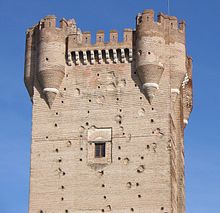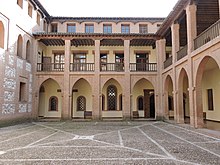Castillo de La Mota
| Castillo de La Mota | ||
|---|---|---|
|
Castillo de La Mota, August 2011 |
||
| Alternative name (s): | La Mota | |
| Creation time : | 13-15 century | |
| Castle type : | Hilltop castle | |
| Conservation status: | Substantially preserved or restored | |
| Standing position : | Noble | |
| Construction: | Masonry bricks | |
| Place: | Medina del Campo | |
| Geographical location | 41 ° 18 ′ 32 " N , 4 ° 54 ′ 30" W | |
| Height: | 739 m above sea level NHN | |
|
|
||
The Castillo de La Mota is a medieval castle and fortress in the city of Medina del Campo , in the province of Valladolid of the Spanish autonomous community of Castile and León . It is located on a hill ( La Mota in Spanish ) and towers over the city. It was once used as a defense and military base. Since November 8, 1904, the complex has been recognized as a national cultural asset of Spain ( Bien de Interés Cultural ) in the Conjunto histórico-artístico category .
architecture
The hilltop castle was built mainly from the light reddish brick typical of the area . This is a hallmark of many Spanish-Arabic castles in the Mudejar style . Only architectural details such as coats of arms and loopholes were made from natural stone. The regular holes in the outer walls come from armor wood , the scaffolding with support beams used for the construction of medieval buildings. One of the most visually distinctive features is the barbican , the large curtain wall with loopholes around the castle. From the bottom of the surrounding trench , the curtain wall has a height of almost 20 m. There is also an inner curtain wall for defense by archers.
The layout of the fortress is trapezoidal. The large square inner courtyard is surrounded by four towers in which the living rooms were located. The castle also has a five-storey, square torre del homenaje , a donjon-like , representative main tower. At 44 meters, it is the tallest castle tower in Castile. The castle chapel of Santa María del Castillo is located in the castle.
The castle was originally accessed via a drawbridge . Today the main gate is accessible via a permanently installed wooden bridge. It consists of an archway between two towers. A coat of arms stone with the royal coat of arms of the Catholic kings is walled in above the archway .
history
The origins of the castle go back to the 11th century. Medina del Campo was founded on the hill La Mota around 1070 to 1080. With the settlement and enclosure of the city, forerunners of the castle complex also emerged. The first inner castle dates from the 13th century. These old foundations can still be found today in the southwestern part of the castle. In 1390, John I of Castile gave his ten-year-old son Ferdinand of Aragón the gift of the city and the associated castle. After Ferdinand's death, the city passed to his son John of Aragón . Johann himself was born in Medina del Campo in 1397 or 1398.
15th century
The military clashes that broke out after the death of Ferdinand I between John II of Castile and his cousins, the sons of Ferdinand I, the Infantes de Aragón (Aragonese), including John of Aragon, led to the rule of Medina del Campo changed hands several times and was at times divided. While the Aragonese held the castle hill, John II of Castile ruled the town center. During these long-standing conflicts in the first half of the 15th century, John of Aragón had the fortress expanded.
In order to finally secure his claims in Castile, John of Aragón marched into Castile with a force from Navarre in 1445 . At the Battle of Olmedo, however, he and other members of the Castilian nobility were defeated. Castile and with it Medina del Campo and the Castillo de La Mota finally fell to the Crown of Castile .
Henry IV of Castile , the son of John II, ordered the construction of the main tower of the castle ("la torre de la mota") in 1460. In 1464 Heinrich donated the castle to the Archbishop of Toledo , Alfonso Carrillo . In 1465 the bishop took part in the rebellion against Heinrich, the Farsa de Ávila , in order to crown his eleven-year-old half-brother Alfonso of Castile . Between 1465 and 1468 there were repeated armed clashes between Heinrich's troops and Alfons' supporters. After Alfonso's death on July 5, 1468, the rebellion, which was based entirely on Alfonso's person, quickly collapsed. In the following years the Castillo de La Mota changed hands several times.
After Henry's death in 1474, the Castillo de La Mota was given by the Fonseca family as a wedding gift to the Catholic kings , Henry's sister Isabella of Castile and her husband Ferdinand II of Aragón . Between 1480 and 1483 the castle was significantly expanded by the barbican and other defensive structures. The curtain wall is equipped with several underground, interconnected passages and a number of rooms that were used to defend the castle.
During the reign of Henry IV and the reign of the Catholic Kings, the castle temporarily housed the royal archive. The Castillo de La Mota was one of Isabella's favorite residences and was regularly visited by the royal family.
16th Century

In the 16th century, Castillo de La Mota served as a state prison . Isabella had her own daughter Johanna the Mad arrested there in 1503 by the Archbishop of Santiago de Compostela, Alonso de Fonseca II . Johanna and her husband Philip I of Austria had previously been recognized as heir to the throne by the Cortes , the Castilian assembly of estates, after the death of Johanna's older siblings on May 22, 1502 in the Cathedral of Toledo . Isabella only released her daughter in 1504.
Another prisoner at the castle was Cesare Borgia . In 1504, under pressure from King Ferdinand , he was captured in Naples and exiled to Spain. After spending a year in solitary confinement in the Castillo de Chinchilla de Montearagón , he was transferred to the Castillo de La Mota in 1505. In October 1506 he managed a spectacular escape from the prison tower with the help of a silk cord.
Later, due to its size, the Castillo de La Mota served as a military base and artillery depot. During the Castilian Comuneros uprising from 1520 to 1522 against the Habsburg King Charles I , the fortress and the city of Medina del Campo were fiercely fought between the royal troops and the Castilian rebels. However, the insurgents did not succeed in taking them.
Hernando Pizarro was imprisoned in La Mota from 1540 to 1561 .
17th century until today
From the 17th century the castle slowly fell into disrepair. Individual parts were repeatedly repaired. Nevertheless, the overall structural condition deteriorated increasingly into the 20th century.
In 1649 the destroyed bridge of the castle was rebuilt on the still existing supporting pillars.
In 1774 Leopoldo de Gregorio made an inventory of the fortress. At this point in time, parts of the trench had already been severely eroded, making parts of the castle unstable.
At the beginning of the 20th century, the restoration of the exterior of the castle began. In 1903 the restoration of the castle was publicly approved and a year later it was officially declared a national treasure. This public attention meant that the first restoration work began as early as 1905. Between 1913 and 1916, the battlements and parapets, which were mostly destroyed by artillery fire, were renewed, imitating the few original parts that had been preserved. Later the weir keep and towers were also restored.
After the Spanish Civil War , dictator Francisco Franco gave the fortress to the Falange Española Tradicionalista y de las Juntas de Ofensiva Nacional Sindicalista (FET y de las JONS) party, which he founded on April 19, 1937 . It served as the headquarters of the Sección Femenina , the party's women's organization. Further restoration work was carried out on and in the castle during Franquism . Among other things, the inner courtyard was completely rebuilt according to the historical model in the Mudejar style.
As part of an architectural and historical inventory of the Castillo de La Mota at the end of the 20th century, the complex was first comprehensively examined and mapped including the underground passages and facilities.
After an extensive restoration of the main tower, it has been open to visitors again since 2010.
literature
- Heribert J. Leonardy, Hendrik Kersten: Castles in Spain. A trip to the Spanish Middle Ages. Darmstadt 2002, pp. 152–157.
Web links
- Website of the Castillo de La Mota (Spanish)
- Burgenwelt: Information about the castle with floor plan (German)
Individual evidence
- ↑ Entry in the cultural assets database ((RI) - 51 - 0000084 - 00000). Ministerio de Cultura y Deporte, accessed April 10, 2019 .
- ^ Scaffolding in the Middle Ages (with graphics). Monuments. Magazine for monument culture in Germany, accessed on April 12, 2019 .
- ↑ a b c d Castillo de La Mota. Fundación Museo de las Ferias, accessed April 12, 2019 .
- ↑ Boada Gozalez, Francisco Javier: " Ars Aurificis: Laus Deo, sumptus hominibus". En Miguel Ángel Zalama Rodríguez. Juana I en Tordesillas: Su mundo, su entorno. Ayuntamiento de Tordesillas, Valladolid 2010. ISBN 978-84-932810-9-0 .
- ↑ Pastor, Víctor & Egido, Luis & Aguado, Roberto & Manrique Arribas, Juan Carlos: La laboratory formativa desarrollada por la Sección Femenina de la Falange en la preparación de los mandos e instructoras durante el periodo franquista. Historia de la educación: Revista interuniversitaria, ISSN 0212-0267, Nº 27, 2008, pags. 347-365. (span.)




